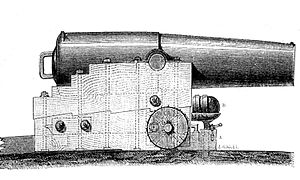Paixhans gun
| Paixhans gun (Canon Paixhans) |
|
|---|---|

Paixhans naval shell gun. Musée de la Marine.
|
|
| Type | Naval artillery |
| Place of origin | France |
| Service history | |
| Used by | France, United States, Russia |
| Wars | Second Opium War, Anglo-French blockade of the Río de la Plata, Mexican-American War, Danish-Prussian War, Crimean War, American Civil War |
| Production history | |
| Designer | Henri-Joseph Paixhans |
| Designed | 1823 |
| Specifications | |
| Weight | 7,400 pounds (3,400 kg) |
| Length | 9 feet 4 inches (2.84 m) |
|
|
|
| Shell | 30 kg (59 lb.) shell |
| Caliber | 22 cm (8.7-inch) |
| Muzzle velocity | 400 m/s (1,200 ft/s) |
The Paixhans gun (French: Canon Paixhans) was the first naval gun designed to fire explosive shells. It was developed by the French general Henri-Joseph Paixhans in 1822-1823. The design would further the development of naval artillery evolution into the modern age. Its use presaged the end of wood as the preferred material in naval warships and the rise of the ironclad.
Explosive shells had long been in use in ground warfare (in howitzers and mortars), but they were fired only at high angles and with relatively low velocities. The shells of that time were inherently dangerous to handle, and no method had been found to combine the explosive character of the shells with the high power and flatter trajectory of a high velocity gun.
However, before the advent of radar and modern optical controlled firing, high trajectories were not practical for marine combat. Naval combat essentially required flat-trajectory guns in order to have a reasonable chance of hitting the target. Therefore, naval warfare had consisted for centuries of encounters between flat-trajectory cannons using inert cannonballs, which could inflict only local damage even on wooden hulls.
Paixhans advocated using flat-trajectory shell guns against warships in 1822 in his Nouvelle force maritime et artillerie.
Paixhans developed a delaying mechanism that for the first time allowed shells to be fired safely in high-powered flat-trajectory guns. The effect of explosive shells lodging into wooden hulls, and then detonating, was potentially devastating. Henri-Joseph Paixhans first demonstrated this in trials against the two-decker Pacificateur in 1824, in which he successfully broke up the ship. Two prototype Paixhans guns had been founded in 1823 and 1824 for this test. Paixhans reported the results in Experiences faites sur une arme nouvelle. The shells were equipped with a fuse that ignited automatically when the gun was fired. The shell would then lodge itself in the wooden hull of the target, before exploding a moment later:
The shells which produced those very extensive ravages upon the Pacificator hulk in the experiments made at Brest, in 1821 and 1824, upon the evidences of which the French naval shell system was founded, were loaded shells, having fuzes attached, which, ignited by the explosion of the discharge in the gun, continued to burn for a time somewhat greater than that of the estimated flight, and then exploded; thus producing the maximum effect which any shell is capable of producing on a ship.
...
Wikipedia
